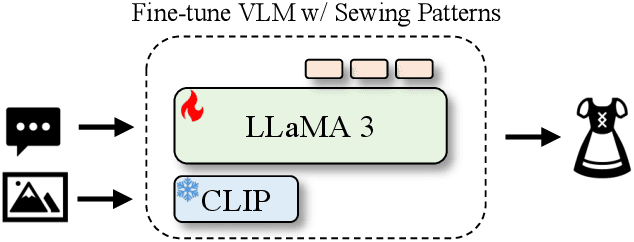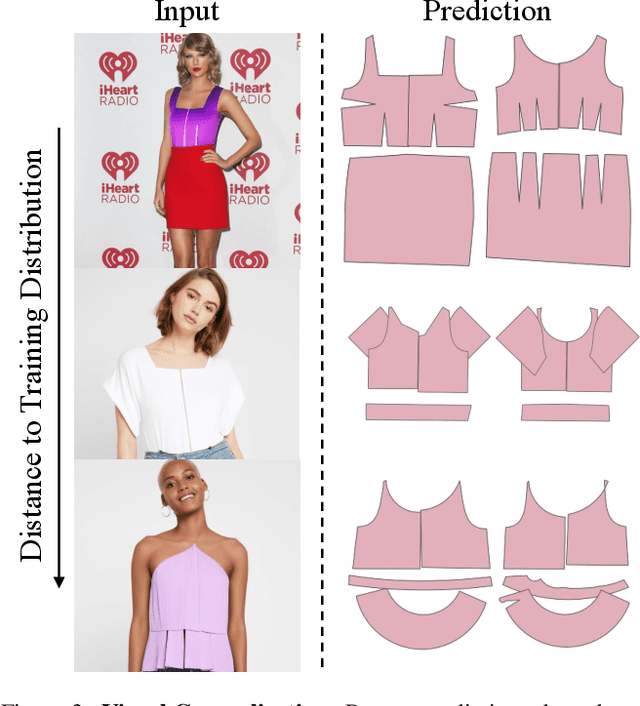Gordon Wetzstein
pi-Flow: Policy-Based Few-Step Generation via Imitation Distillation
Oct 16, 2025Abstract:Few-step diffusion or flow-based generative models typically distill a velocity-predicting teacher into a student that predicts a shortcut towards denoised data. This format mismatch has led to complex distillation procedures that often suffer from a quality-diversity trade-off. To address this, we propose policy-based flow models ($\pi$-Flow). $\pi$-Flow modifies the output layer of a student flow model to predict a network-free policy at one timestep. The policy then produces dynamic flow velocities at future substeps with negligible overhead, enabling fast and accurate ODE integration on these substeps without extra network evaluations. To match the policy's ODE trajectory to the teacher's, we introduce a novel imitation distillation approach, which matches the policy's velocity to the teacher's along the policy's trajectory using a standard $\ell_2$ flow matching loss. By simply mimicking the teacher's behavior, $\pi$-Flow enables stable and scalable training and avoids the quality-diversity trade-off. On ImageNet 256$^2$, it attains a 1-NFE FID of 2.85, outperforming MeanFlow of the same DiT architecture. On FLUX.1-12B and Qwen-Image-20B at 4 NFEs, $\pi$-Flow achieves substantially better diversity than state-of-the-art few-step methods, while maintaining teacher-level quality.
Taming Flow-based I2V Models for Creative Video Editing
Sep 26, 2025Abstract:Although image editing techniques have advanced significantly, video editing, which aims to manipulate videos according to user intent, remains an emerging challenge. Most existing image-conditioned video editing methods either require inversion with model-specific design or need extensive optimization, limiting their capability of leveraging up-to-date image-to-video (I2V) models to transfer the editing capability of image editing models to the video domain. To this end, we propose IF-V2V, an Inversion-Free method that can adapt off-the-shelf flow-matching-based I2V models for video editing without significant computational overhead. To circumvent inversion, we devise Vector Field Rectification with Sample Deviation to incorporate information from the source video into the denoising process by introducing a deviation term into the denoising vector field. To further ensure consistency with the source video in a model-agnostic way, we introduce Structure-and-Motion-Preserving Initialization to generate motion-aware temporally correlated noise with structural information embedded. We also present a Deviation Caching mechanism to minimize the additional computational cost for denoising vector rectification without significantly impacting editing quality. Evaluations demonstrate that our method achieves superior editing quality and consistency over existing approaches, offering a lightweight plug-and-play solution to realize visual creativity.
Mixture of Contexts for Long Video Generation
Aug 28, 2025Abstract:Long video generation is fundamentally a long context memory problem: models must retain and retrieve salient events across a long range without collapsing or drifting. However, scaling diffusion transformers to generate long-context videos is fundamentally limited by the quadratic cost of self-attention, which makes memory and computation intractable and difficult to optimize for long sequences. We recast long-context video generation as an internal information retrieval task and propose a simple, learnable sparse attention routing module, Mixture of Contexts (MoC), as an effective long-term memory retrieval engine. In MoC, each query dynamically selects a few informative chunks plus mandatory anchors (caption, local windows) to attend to, with causal routing that prevents loop closures. As we scale the data and gradually sparsify the routing, the model allocates compute to salient history, preserving identities, actions, and scenes over minutes of content. Efficiency follows as a byproduct of retrieval (near-linear scaling), which enables practical training and synthesis, and the emergence of memory and consistency at the scale of minutes.
Random-phase Gaussian Wave Splatting for Computer-generated Holography
Aug 24, 2025Abstract:Holographic near-eye displays offer ultra-compact form factors for virtual and augmented reality systems, but rely on advanced computer-generated holography (CGH) algorithms to convert 3D scenes into interference patterns that can be displayed on spatial light modulators (SLMs). Gaussian Wave Splatting (GWS) has recently emerged as a powerful CGH paradigm that allows for the conversion of Gaussians, a state-of-the-art neural 3D representation, into holograms. However, GWS assumes smooth-phase distributions over the Gaussian primitives, limiting their ability to model view-dependent effects and reconstruct accurate defocus blur, and severely under-utilizing the space-bandwidth product of the SLM. In this work, we propose random-phase GWS (GWS-RP) to improve bandwidth utilization, which has the effect of increasing eyebox size, reconstructing accurate defocus blur and parallax, and supporting time-multiplexed rendering to suppress speckle artifacts. At the core of GWS-RP are (1) a fundamentally new wavefront compositing procedure and (2) an alpha-blending scheme specifically designed for random-phase Gaussian primitives, ensuring physically correct color reconstruction and robust occlusion handling. Additionally, we present the first formally derived algorithm for applying random phase to Gaussian primitives, grounded in rigorous statistical optics analysis and validated through practical near-eye display applications. Through extensive simulations and experimental validations, we demonstrate that these advancements, collectively with time-multiplexing, uniquely enables full-bandwith light field CGH that supports accurate accurate parallax and defocus, yielding state-of-the-art image quality and perceptually faithful 3D holograms for next-generation near-eye displays.
Captain Cinema: Towards Short Movie Generation
Jul 24, 2025Abstract:We present Captain Cinema, a generation framework for short movie generation. Given a detailed textual description of a movie storyline, our approach firstly generates a sequence of keyframes that outline the entire narrative, which ensures long-range coherence in both the storyline and visual appearance (e.g., scenes and characters). We refer to this step as top-down keyframe planning. These keyframes then serve as conditioning signals for a video synthesis model, which supports long context learning, to produce the spatio-temporal dynamics between them. This step is referred to as bottom-up video synthesis. To support stable and efficient generation of multi-scene long narrative cinematic works, we introduce an interleaved training strategy for Multimodal Diffusion Transformers (MM-DiT), specifically adapted for long-context video data. Our model is trained on a specially curated cinematic dataset consisting of interleaved data pairs. Our experiments demonstrate that Captain Cinema performs favorably in the automated creation of visually coherent and narrative consistent short movies in high quality and efficiency. Project page: https://thecinema.ai
Video World Models with Long-term Spatial Memory
Jun 05, 2025



Abstract:Emerging world models autoregressively generate video frames in response to actions, such as camera movements and text prompts, among other control signals. Due to limited temporal context window sizes, these models often struggle to maintain scene consistency during revisits, leading to severe forgetting of previously generated environments. Inspired by the mechanisms of human memory, we introduce a novel framework to enhancing long-term consistency of video world models through a geometry-grounded long-term spatial memory. Our framework includes mechanisms to store and retrieve information from the long-term spatial memory and we curate custom datasets to train and evaluate world models with explicitly stored 3D memory mechanisms. Our evaluations show improved quality, consistency, and context length compared to relevant baselines, paving the way towards long-term consistent world generation.
Towards Vision-Language-Garment Models For Web Knowledge Garment Understanding and Generation
Jun 05, 2025



Abstract:Multimodal foundation models have demonstrated strong generalization, yet their ability to transfer knowledge to specialized domains such as garment generation remains underexplored. We introduce VLG, a vision-language-garment model that synthesizes garments from textual descriptions and visual imagery. Our experiments assess VLG's zero-shot generalization, investigating its ability to transfer web-scale reasoning to unseen garment styles and prompts. Preliminary results indicate promising transfer capabilities, highlighting the potential for multimodal foundation models to adapt effectively to specialized domains like fashion design.
Multiscale guidance of AlphaFold3 with heterogeneous cryo-EM data
Jun 04, 2025Abstract:Protein structure prediction models are now capable of generating accurate 3D structural hypotheses from sequence alone. However, they routinely fail to capture the conformational diversity of dynamic biomolecular complexes, often requiring heuristic MSA subsampling approaches for generating alternative states. In parallel, cryo-electron microscopy (cryo-EM) has emerged as a powerful tool for imaging near-native structural heterogeneity, but is challenged by arduous pipelines to go from raw experimental data to atomic models. Here, we bridge the gap between these modalities, combining cryo-EM density maps with the rich sequence and biophysical priors learned by protein structure prediction models. Our method, CryoBoltz, guides the sampling trajectory of a pretrained protein structure prediction model using both global and local structural constraints derived from density maps, driving predictions towards conformational states consistent with the experimental data. We demonstrate that this flexible yet powerful inference-time approach allows us to build atomic models into heterogeneous cryo-EM maps across a variety of dynamic biomolecular systems including transporters and antibodies.
Long-Context State-Space Video World Models
May 26, 2025Abstract:Video diffusion models have recently shown promise for world modeling through autoregressive frame prediction conditioned on actions. However, they struggle to maintain long-term memory due to the high computational cost associated with processing extended sequences in attention layers. To overcome this limitation, we propose a novel architecture leveraging state-space models (SSMs) to extend temporal memory without compromising computational efficiency. Unlike previous approaches that retrofit SSMs for non-causal vision tasks, our method fully exploits the inherent advantages of SSMs in causal sequence modeling. Central to our design is a block-wise SSM scanning scheme, which strategically trades off spatial consistency for extended temporal memory, combined with dense local attention to ensure coherence between consecutive frames. We evaluate the long-term memory capabilities of our model through spatial retrieval and reasoning tasks over extended horizons. Experiments on Memory Maze and Minecraft datasets demonstrate that our approach surpasses baselines in preserving long-range memory, while maintaining practical inference speeds suitable for interactive applications.
Dual Ascent Diffusion for Inverse Problems
May 23, 2025Abstract:Ill-posed inverse problems are fundamental in many domains, ranging from astrophysics to medical imaging. Emerging diffusion models provide a powerful prior for solving these problems. Existing maximum-a-posteriori (MAP) or posterior sampling approaches, however, rely on different computational approximations, leading to inaccurate or suboptimal samples. To address this issue, we introduce a new approach to solving MAP problems with diffusion model priors using a dual ascent optimization framework. Our framework achieves better image quality as measured by various metrics for image restoration problems, it is more robust to high levels of measurement noise, it is faster, and it estimates solutions that represent the observations more faithfully than the state of the art.
 Add to Chrome
Add to Chrome Add to Firefox
Add to Firefox Add to Edge
Add to Edge